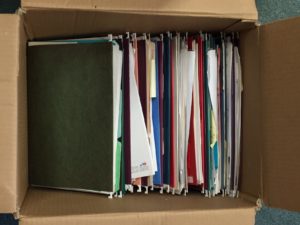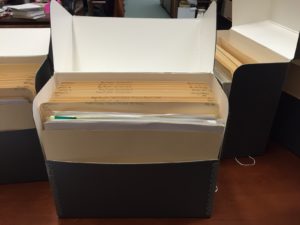– by Mary Hanes, Archives intern
The records generated by organizations provide important evidence about the organization’s history and function. In January of 2016, I started to process the College of Physicians of Philadelphia Office of the Executive Director records. The Director oversees the everyday governance and administration of the College. This includes overseeing the budget, strategic planning, special projects, and creating and maintaining relationships with other institutions. With so many responsibilities, the office generates a considerable amount of documentation, from correspondence to meeting minutes. The scope of my project includes processing boxes the Library received from the Office of the Executive Director and arranging them to better document the office’s administrative activities and governance duties.
Because the Executive Director’s Office produces so many files, the office keeps active records and sends the inactive files in boxes to the Library. Boxes arrive with varying levels of organization. Recently, the executive assistant to the current CEO requested minutes from a specific committee meeting. Although the material was located, it became clear that the collection needed processing to make it more accessible for current staff and future external researchers.

The next question was how to process a collection of so many papers efficiently. For this collection, I used the strategy of minimal processing: a means of processing a collection quickly and efficiently. Minimal processing became a more prominent processing approach after Mark Greene and Dennis Meissner published their article “More Product, Less Process: Pragmatically Revamping Traditional Processing Approaches to Deal with Late 20th Century Collections” in 2005. Greene and Meissner suggested shortening processing time by processing at the folder level, instead of creating a folder for each sheet or packet of paper and giving a more general overview of collections instead of a deep study of each record. This collection of executive papers is a good candidate for minimal processing because the records are recent with no preservation issues and they already have discernible order.
Maintaining the original order of the collection whenever possible is another part of processing. Just because the collection needed arranging did not mean there was not already some semblance of order. Maintaining the original order has a twofold advantage: quicker processing time for the archivist and a truer representation of how the creator, the Executive Director’s Office, used the papers. Some boxes contained hanging file folders while others stored various media with indeterminate subject matter. I started by sorting through the boxes, identifying which materials should be kept and which could be removed. I also noted prominent subjects and series. Arranging the papers into coherent series and subseries helps the researcher better understand the contents of the collection.
One of the major series identified contains the records of former Executive Director Marc Micozzi. Dr. Micozzi, a physician and anthropologist, served as the Executive Director from 1995 to 2002 after serving on the College of Physicians Board of Advisors. A large part of the Micozzi series is correspondence written to colleagues, maintaining professional relationships and promoting special projects at the College of Physicians. The Micozzi series also includes files from a few special projects he oversaw, such as museum building renovations and grant proposals.
Although the Director oversees all of the functions in the College, other governing bodies contribute to the running of the institution. The Governance series includes records from the different boards and councils that help the College function. Meeting agendas and minutes, reports, and correspondence comprise the series and provide a glimpse into the issues the boards dealt with. Within this series are subseries related to different administrative bodies and efforts. The “Standing and ad hoc committees” subseries deals with the administrative functions of the College of Physicians’ committees. For example, it includes papers from the Committee on Nominations that oversaw the nomination of new board members as well as the election process. The By-Laws subseries is of particular importance, as it shows the evolution of the College of Physician’s by-laws through edits and final drafts throughout the years.
The Operations series covers building renovations, including significant additions to the library and museum spaces in the late 1990’s and early 2000’s. Contracts with vendors, renovation plans, and building surveys provide insight into the condition of the building and the different goals for its future.

As I finish processing this collection, my first independent processing project, I realize how much I have learned, both about archives and organizational papers. As an undergraduate, I studied Art Conservation, a field that emphasizes saving everything that might serve as historical evidence and documenting every last detail. This experience in minimal processing taught me that it is still possible to provide sufficient historical evidence with efficiency. For example, instead of an entire stack of information packets from a strategic planning meeting, I saved two copies. Now there are multiple copies but also more space for other documents in the collection. Also, processing is actually quite a process with unexpected issues to resolve. I thought I only had one more box left to process but found a couple more on the shelf. I had to reevaluate my processing plan and figure out how to place the new records into appropriate subseries. Furthermore, I found learning how a not-for-profit organization is governed exceedingly interesting, especially when I encountered strongly worded memos between board members regarding important issues.
For the final part of processing the collection, I will write a finding aid, a document that provides a historical context for a collection as well as an inventory of the materials in the collection. That finding aid will then be made available online in the Library’s ArchivesSpace instance, making the Records of the Office of the Executive Director collection accessible and searchable for researchers both near and far. (To read more about finding aids and ArchivesSpace, check out an earlier blog post here.)
You can view Mary’s finding aid for the collection here.


